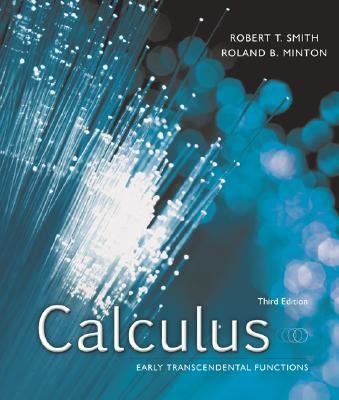5927710
9780073309446
Calculus
by Smith, Robert T., Minton, Roland B.
About this item
- Condition: New
- Provider: gridfreed
- Provider Rating: 68%
- Ships From: San Diego, CA
- Shipping: Standard
- Comments: New. In shrink wrap. Looks like an interesting title!

About this item
- Condition: Good
- Provider: 369pyramidinc
- Provider Rating: 80%
- Ships From: Multiple Locations
- Shipping: Standard
- Comments: Buy with confidence. Excellent Customer Service & Return policy

Product details
- ISBN-13: 9780073309446
- ISBN: 0073309443
- Edition: 3
- Publication Date: 2007
- Publisher: McGraw-Hill Companies, The
AUTHOR
SUMMARY
0 Preliminaries 0.1 Polynomials and Rational Functions 0.2 Graphing Calculators and Computer Algebra Systems 0.3 Inverse Functions 0.4 Trigonometric and Inverse Trigonometric Functions 0.5 Exponential and Logarithmic Functions Hyperbolic Functions Fitting a Curve to Data 0.6 Transformations of Functions 1 Limits and Continuity 1.1 A Brief Preview of Calculus: Tangent Lines and the Length of a Curve 1.2 The Concept of Limit 1.3 Computation of Limits 1.4 Continuity and its Consequences The Method of Bisections 1.5 Limits Involving Infinity Asymptotes 1.6 Formal Definition of the Limit Exploring the Definition of Limit Graphically 1.7 Limits and Loss-of-Significance Errors Computer Representation of Real Numbers 2 Differentiation 2.1 Tangent Lines and Velocity 2.2 The Derivative Numerical Differentiation 2.3 Computation of Derivatives: The Power Rule Higher Order Derivatives Acceleration 2.4 The Product and Quotient Rules 2.5 The Chain Rule 2.6 Derivatives of the Trigonometric Functions 2.7 Derivatives of the Exponential and Logarithmic Functions 2.8 Implicit Differentiation and Inverse Trigonometric Functions 2.9 The Mean Value Theorem 3 Applications of Differentiation 3.1 Linear Approximations and Newton's Method 3.2 Indeterminate Forms and L'Hopital's Rule 3.3 Maximum and Minimum Values 3.4 Increasing and Decreasing Functions 3.5 Concavity and the Second Derivative Test 3.6 Overview of Curve Sketching 3.7 Optimization 3.8 Related Rates 3.9 Rates of Change in Economics and the Sciences 4 Integration 4.1 Antiderivatives 4.2 Sums and Sigma Notation Principle of Mathematical Induction 4.3 Area 4.4 The Definite Integral Average Value of a Function 4.5 The Fundamental Theorem of Calculus 4.6 Integration by Substitution 4.7 Numerical Integration Error Bounds for Numerical Integration 4.8 The Natural Logarithm as an Integral The Exponential Function as the Inverse of the Natural Logarithm 5 Applications of the Definite Integral 5.1 Area Between Curves 5.2 Volume: Slicing, Disks, and Washers 5.3 Volumes by Cylindrical Shells 5.4 Arc Length and Surface Area 5.5 Projectile Motion 5.6 Applications of Integration to Physics and Engineering 5.7 Probability 6 Integration Techniques 6.1 Review of Formulas and Techniques 6.2 Integration by Parts 6.3 Trigonometric Techniques of Integration Integrals Involving Powers of Trigonometric Functions Trigonometric Substitution 6.4 Integration of Rational Functions Using Partial Fractions Brief Summary of Integration Techniques 6.5 Integration Tables and Computer Algebra Systems 6.6 Improper Integrals A Comparison Test 7 First-Order Differential Equations 7.1 Modeling with Differential Equations Growth and Decay Problems Compound Interest 7.2 Separable Differential Equations Logistic Growth 7.3 Direction Fields and Euler's Method 7.4 Systems of First-Order Differential Equations Predator-Prey Systems 8 Infinite Series 8.1 Sequences of Real Numbers 8.2 Infinite Series 8.3 The Integral Test and Comparison Tests 8.4 Alternating Series Estimating the Sum of an Alternating Series 8.5 Absolute Convergence and the Ratio Test The Root Test Summary of Convergence Tests 8.6 Power Series 8.7 Taylor Series Representations of Functions as Series Proof of Taylor's Theorem 8.8 Applications of Taylor Series The Binomial Series 8.9 Fourier Series 9 Parametric Equations and Polar Coordinates 9.1 Plane Curves and Parametric Equations 9.2 Calculus and Parametric Equations 9.3 Arc Length and Surface Area in Parametric Equations 9.4 Polar Coordinates 9.5 Calculus and Polar Coordinates 9.6 Conic Sections 9.7 Conic Sections in Polar Coordinates 10 Vectors and thSmith, Robert T. is the author of 'Calculus', published 2007 under ISBN 9780073309446 and ISBN 0073309443.
[read more]


